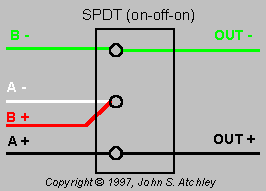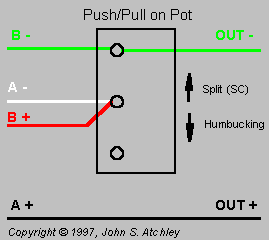Humbucker Switching
Useful, and not so Useful, Humbucker Wiring
I've experimented quite a bit with four-wire humbuckers, and have decided that, in my opinion, the usefulness of the various possible configurations can be rated as follows (most useful to least useful):
- Splitting (single coil): One coil is shorted out (if humbucker is wired for parallel operation the circuit to one end of one coil is broken -- this tends to be susceptible to noise). This allows operation in normal humbucking or in single coil mode. This is most usefull with fairly "hot" humbuckers. Splitting "soft" humbuckers tends to result in a very weak single-coil sound similar to the wimpy pickups on the very cheap Asian Strats.
- Series/Parallel switching: Allows wiring the two coils of the humbucker in series ("normal") or in parallel. The tones are different and series tends to be a bit hotter.
- Splitting allowing use of either coil as single coil: In most applications this is of little use -- I simply can't hear any difference between the two coils when used as single coils. Where this could be useful is when combined with other switching mods. For example, if you have set up your pickup selection to allow the neck/bridge combination (as well as mid/bridge), then you would want to select one coil for hum-cancelling with the neck and the other for hum-cancelling with the middle. Another case where this could be useful is if you are uncertain of the polarity of the mid pickup. This would allow you to select the "correct" (hum-cancelling with mid) coil of the humbucker without having to disassemble the guitar to swap wires around if you got it "wrong" the first time. Finally, allowing selection of either coil doesn't "cost" anything (assuming it is the only switching you are doing on the humbucker) -- you still have only one switch and simply use a SPDT on-off-on instead of a SPST switch.
- Phasing the two coils: The ability to put the two coils of the humbucker out of phase with each other is even less useful than the ability to put two pickups out of phase with each other. The coils are so close and so similar that you end up with a very weak signal -- plus a lot of noise (the coils become hum-aiding when you put them out of phase).
In short, I believe the most useful capability is to select between single coil, series, and parallel configurations.
You might wonder how I arrived at these conclusions. I put a Pearly Gates with a six-position rotary switch in the bridge of a cheap Strat. The switch allowed me to select either single coil, and series and parallel configurations in and out of phase. It was a great learning experience, but many of the positions were either very similar to others (the two single-coil positions sounded identical) or sounded horrible (the out of phase positions). I decided not to waste time and space with a schematic of this switch because it's really not very useful (all of the useful positions can be achieved much more simply).
If you are more interested in useful switching schemes, check these out (incidentally, there is nothing particularly fancy about these, they have appeared in various forms on other sites and in print). Note: because these are so simple, and because they merely affect one pickup and can thus be easily combined with other modifications (verstaile switch selection and so on), I've chosen to go with much simpler drawings for these showing only the relavent part of the circuit. Leads are shown as plus (+) and minus (-) instead of "ground" and "hot" for simplification. The wires labeled "out +" and "out -" attach to the rest of the guitar circuitry where ordinary single coil plus and minus leads would attach. Color codes shown are for Seymour Duncan pickups.
Splitting (either single coil):
Modifies appearance of guitar (adds mini-toggle). |
 |
| Simple mod uses SPDT on-off-on mini-toggle to allow selection of either single coil or the series humbucker. |
|
Splitting (using push-pull on volume or tone):
Does not modify appearance of guitar. |
 |
| This mod uses a push-pull switch on one of the pots to select between single coil and humbucking operation. |
|
Series/parallel switching (using push/pull on volume or tone):
Does not modify appearance of guitar. |
 |
Series/parallel selection using a DPDT on-none-on switch on one of the pots.
This may also be wired as shown in the next picture. |
|
Series/single/parallel switching:
Modifies appearance of guitar (small toggle switch). |
 |
Series/single/parallel selection on one switch. I have done this using a rotary switch. This solution (from Seymour Duncan) is much simpler but you should be aware that there is more than one switch configuration sold as "on-on-on." Kevin Beller, Chief Engineer at Seymour Duncan, reports that the configuration which works for this circuit is the most common or "standard" on-on-on switch. He has provided the following part numbers as suitable:
| WD Electronics | WDE11 - DPDT on/on/on chrome |
| WDE11b - DPDT on/on/on black |
| Allparts | EP-080 - DPDT on/on/on chrome |
| EP-079 - DPDP on/on/on black |
| EP-129 - DPDT on/on/on gold |
| Newark Electronics | 81F961 - C&K T211SHZQE DPDT on/on/on chrome |
| Alcoswitch | MTA-206PA - DPDT on/on/on chrome |
| Gotoh | MS500 XFB - DPDT on/on/on black |
|
|
|